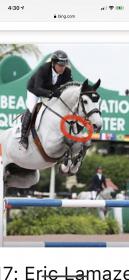I know this is a very vague question but I’ve seen a lot of jumpers go decided out to the MAX in tack and just wondering what that all is? Obviously there are boots, a fly bonnet, saddle, etc, but I see a lot of stuff attached from the girth and or the saddle to the bridle. Does any jumper want to kind of walk me through what tack they have on their horse? Thank you!
You are probably seeing a martingale. Running martingales are popular in jumpers. It’s used mainly to keep the horse from lifting its head too high when approaching the jump. I don’t use one, so someone else should chime in and give you a better explanation.
Jumpers also use hackamores, double reins, and breastplates pretty regularly which can give the appearance of more tack than in the hunters.
It may be better to link a photo so we can see what you are talking about.
A large number of jumpers are likely using a breastplate (3 point/5 point/polo/etc) to avoid the saddle slipping during jumping efforts and tight turns as well as some form of martingale. From the saddle to bridle you would be seeing a martingale. In the US, anyone jumping 1.30m or higher or in young horse classes can only use a running martingale but lower level classes do not have a restriction on the type of martingale (running/bib/standing/German/etc).
So I just started doing jumpers this year after eventing for several years, but I would say I’m pretty minimal on tack. Saddle, pad, half pad, bridle with flash, girth. Sometimes I’ll put one of his bonnets on because #style, and if we’re jumping bigger fences I’ll use his breastplate just to be safe, although we’ve never had a saddle slipping issue without it. I keep his bit really simple too–a full cheek French link. I’m thinking about stepping him down to a full cheek oval link because it’s even softer than the French link. He has a light soft mouth and has never been a heavy puller type.
In his younger days, he was hot in the sense that he was anxious and frantic almost all of the time. If I had dressed him up in a ton of things/gadgets it would’ve sent him over the edge. He’s much quieter and happier now, but I still go with the “less is more” approach with his tack.
He’s moving up in fence heights now, so I really should start putting front boots on him just to be safe. Maybe Santa will bring them this year :lol:
I agree, you’re probably seeing a fig-8 bridle, with breastplate and running martingale - some have a leather panel on them, so it can all look like a lot of leather. And some use pelhams or gags with 2 reins so that’s even more strap leather.
This is just what I wanted!! Thank you so much!
one more question… what is the net-like piece of equipment you see a lot in Grand Prix’s that goes sort of where the martingale is? I attached a photo of it below, you might have to zoom in tho

That’s an Irish martingale
No, it is not.
It’s a bib martingale.
It’s a bib martingale, basically serves the same purpose as a running martingale but without the long straps that a mouthy horse can grab and get stuck through its mouth. And a lot of racing people use it as well because (like an Irish) it keeps the reins from going over the horse’s head when shenanigans occur.
I’ve also known some riders that prefer bib martingales because the leather or fabric in between the rings limits the 2 sides from functioning as independently as a regular running martingale. This provides a more consistent feel through the bridle when you want to turn, etc. Not so one-handed. Easier for some young horses to understand or horses with sensitive mouths to tolerate. Kind of like how you get more cohesive communication between a bit and hackamore shank by using the rein converters instead of double reins.
